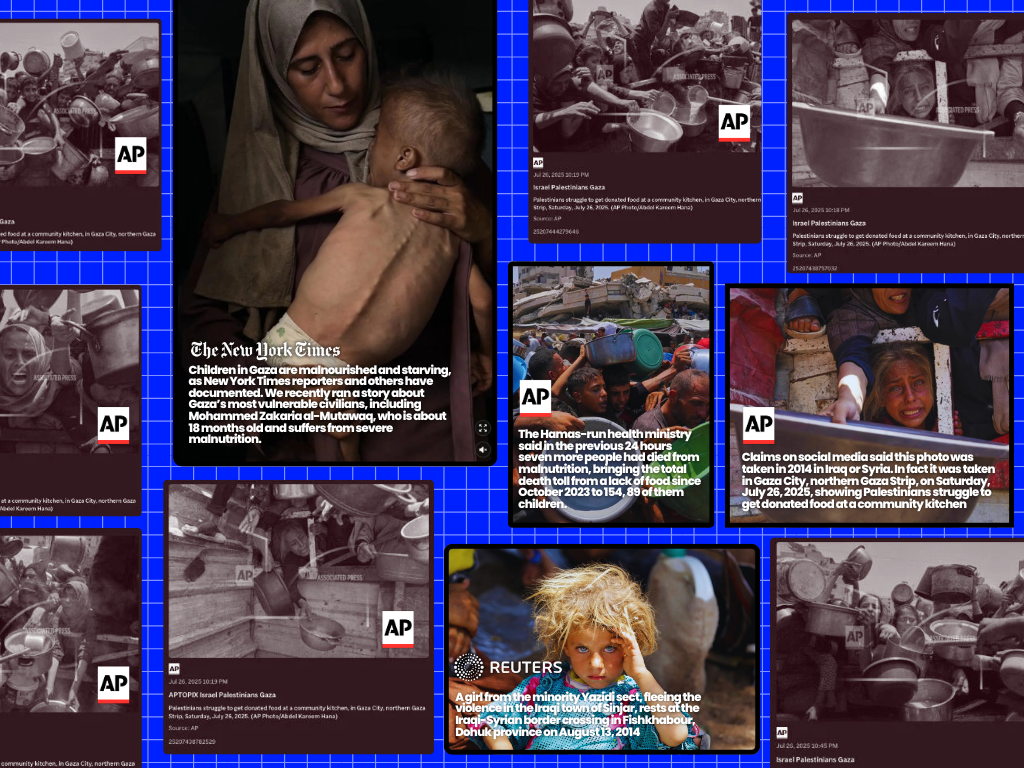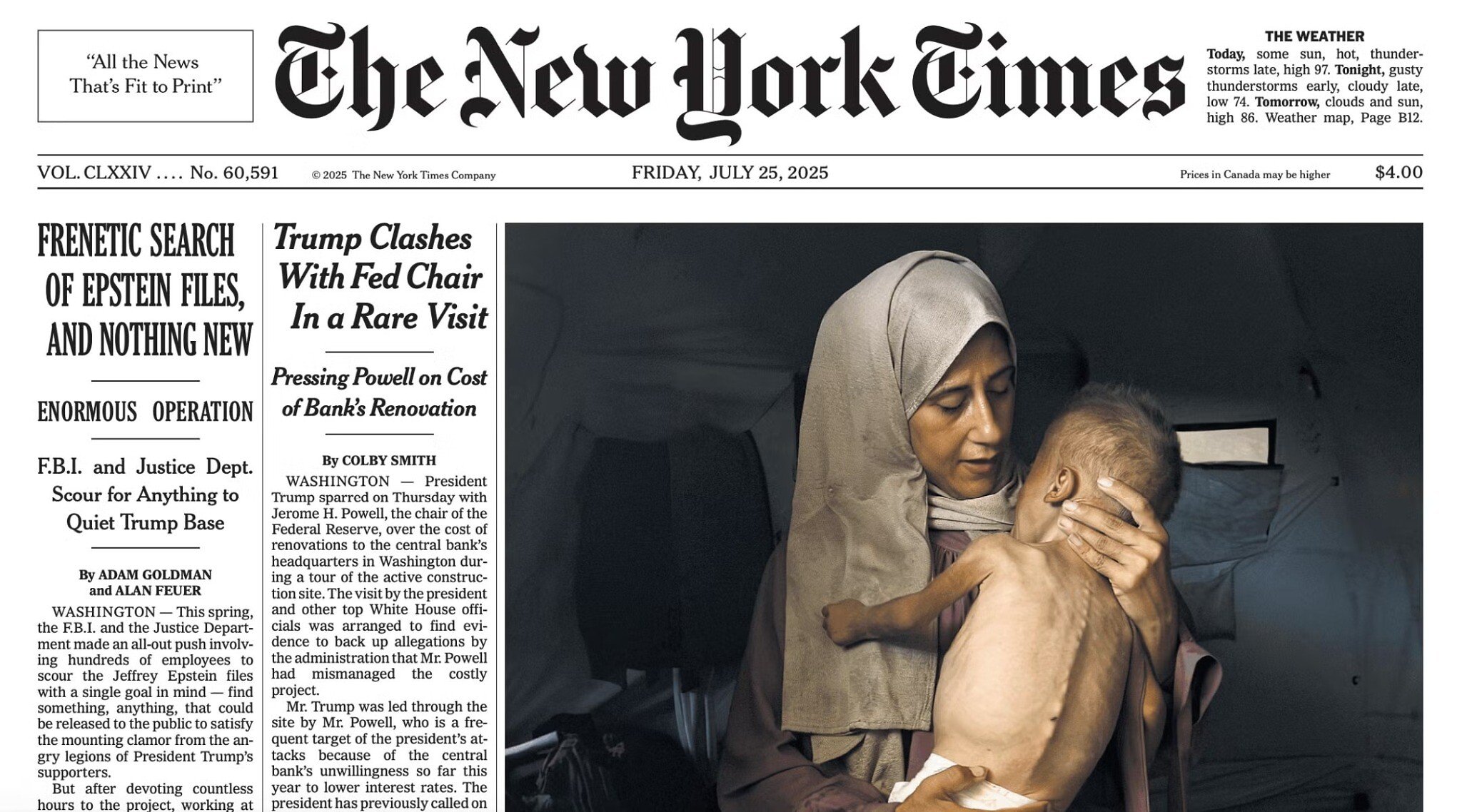
The New York Times’ July 25 front page showing a picture captioned: “Mohammed Zakaria al-Mutawaq, about 18 months, with his mother, Hedaya al-Mutawaq, who said he was born healthy but recently diagnozed with severe malnutrition. A doctor said the number children dying of malnutrition in Gaza had risen sharply.” On July 30, the paper acknowledged that Mohammed “had pre-existing health problems affecting his brain and his muscle development.”
It’s one of the most emotionally searing images circulated in recent months: a malnourished child behind a fence, desperate eyes piercing through the camera lens, with a woman stretching out a bowl for food. It’s been published by international media, invoked by politicians, and shared by millions online. It has come to symbolize, for many, the reported famine in Gaza.
But there’s just one problem. The photo’s origin and context are hotly disputed — and increasingly, experts say, deliberately manipulated.
Earlier this week, Israeli Prime Minister Benjamin Netanyahu told his 3.4 million followers on X:
“There is no starvation in Gaza, no policy of starvation in Gaza.”
His remarks unleashed a digital firestorm. Former President Donald Trump broke ranks with his usual ally and responded:
“There is real starvation in Gaza. You can’t fake that.”
This rare division between two strong allies laid bare the intensifying war not just over territory, but over information — a propaganda war playing out across social media, newsrooms, and governments.
Hamas’s Propaganda Machinery and Media Blindness
Many analysts and security experts argue that Hamas is adept at exploiting global sympathy through carefully staged imagery. Images of skeletal children, overwhelmed hospitals, and food queues are frequently disseminated, often with little journalistic scrutiny.
Take, for instance, the viral image of a girl at a community kitchen. On X (formerly Twitter), thousands of users — aided by Elon Musk’s AI chatbot, Grok — claimed the photo was from 2014, portraying a Yazidi girl fleeing ISIS in Iraq.

Grok responded:
“Yes, the photo is from August 2014… on Mount Sinjar in Iraq.”
Citing Reuters, it labeled the image a case of repurposed content.

But BBC Verify journalist Shayan Sardarizadeh debunked that claim. He identified the photo’s true source:
“The image is from Gaza, taken on July 26, 2025, by AP photographer Abdel Kareem Hana.”
Reverse image tools like TinEye confirmed the original publication date and location. Grok was simply wrong.
As Sardarizadeh noted:
“AI chatbots, including Grok, are not fact-checking tools and should not be used for that purpose, particularly in relation to breaking and developing events.”
Still, damage was done. The manipulated claim was spread, repeated, and believed by many — a clear example of how quickly misinformation can overshadow the truth.
The Case of Mohammed Zakaria al-Mutawaq

The New York Times’ July 25 front page showing a picture captioned: “Mohammed Zakaria al-Mutawaq, about 18 months, with his mother, Hedaya al-Mutawaq, who said he was born healthy but recently diagnozed with severe malnutrition. A doctor said the number children dying of malnutrition in Gaza had risen sharply.” On July 30, the paper acknowledged that Mohammed “had pre-existing health problems affecting his brain and his muscle development.”
Another image that shocked global audiences was that of 18-month-old Mohammed Zakaria al-Mutawaq. Published by The New York Times in a piece titled “Gazans Are Dying of Starvation”, the toddler was described as emaciated, with his father reportedly killed while searching for food.
“As an adult, I can bear the hunger, but my kids can’t,” his mother was quoted.
But investigative journalist David Collier quickly raised flags. He cited medical records showing Mohammed suffered from severe genetic disorders since birth and had required special supplements even before the war began.
In response, The New York Times issued an editor’s note:
“We have since learned new information… and have updated our story to add context about his pre-existing health problems.”
They noted that while Mohammed’s condition had worsened due to the lack of medical care, his malnutrition was compounded, not caused, by the current war.
To critics, the update wasn’t enough.
“So you guys lied, got called out, and issued a complete non-apology,” one user posted on X.
On Wednesday, a UN-backed food security task force warned that famine “is currently playing out” in Gaza. Their analysis said Gaza City had crossed famine thresholds for food consumption and acute malnutrition.
The Hamas-run Gaza Health Ministry reports 154 deaths from hunger since October 2023 — including 89 children. However, critics question the credibility of the ministry’s figures, noting its alignment with Hamas and history of inflated or unverifiable statistics.
Meanwhile, UN Secretary-General António Guterres called the situation “a humanitarian catastrophe of epic proportions.” Human rights organizations, including Israel-based B’Tselem and Physicians for Human Rights, claim Israel is committing genocide through starvation, mass displacement, and bombings.
Yet at the same time, The New York Times also recently reported Israeli military officials denying Hamas’s alleged theft of UN aid — suggesting the crisis may be more due to distribution chaos, logistical breakdowns, and internal Hamas mismanagement than direct Israeli policy.
A Media Reckoning Is Overdue
The Western media’s responsibility in this tragedy cannot be ignored. In the rush to file emotionally evocative stories, due diligence has often been sacrificed. As the New York Budgets Editorial Standards outline: verifying visual content, especially in wartime, is not optional — it is essential.
“Every journalist must ask: Who took this photo? Where? When? Under what conditions?”
Hamas has repeatedly demonstrated it will exploit suffering for propaganda. That doesn’t mean suffering isn’t real — but it does mean every claim must be thoroughly scrutinized. Too often, however, global outlets like The New York Times, The Guardian, and Stuff have published without confirmation, only issuing updates days later.
Starvation in Gaza may well be occurring. Humanitarian groups have sounded the alarm. But in a media landscape rife with misinformation, every image, every anecdote must be questioned — not to deny suffering, but to preserve the truth.
Because when lies masquerade as evidence, the real victims — whether Palestinian civilians or the truth itself — are the ones who suffer the most.






1 Comment
Pingback: German Billionaire Eyes Wall Street Journal Buyout - The New York Budgets